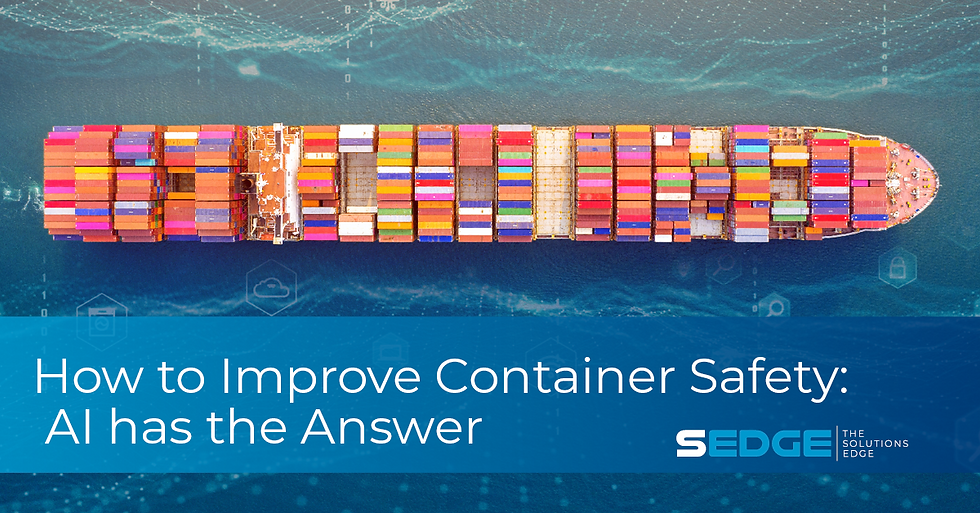
The maritime industry is fraught with challenges: poor weather conditions, congested ports, equipment breakdowns, and containers lost at sea. An unplanned delay or mishap on just one ship can mean logistical nightmares for an entire fleet, impacting multiple ports, supply chains, and profits down the line.
The business of transporting containers is good, and it is booming. In 2019, the global liner shipping industry transported close to 226 million containers, moving cargo worth over US$4 trillion. As the quantity of goods carried by containers has increased from 102 million metric tons 40 years ago to around 1.83 billion metric tons more recently, so too have vessels expanded their capacity from around 11 million metric tons to approximately 266 million metric tons.


Containers Lost Overboard
With the increase in load capacity comes the exponential risk of damage and loss. The number of containers lost at sea has been particularly high these last few months. In February this year a Maersk ship lost an undisclosed number of containers filled with furniture, clothing, electronics, cookware and toys. This happened on the back of a catastrophic loss of 750 containers in the Pacific in January this year, while the One Apus lost an estimated 2,000 containers in November last year, with an estimated insurance claim of more than $220 million. These are just to name a few.
In an attempt to understand how many containers are actually lost at sea, the World Shipping Council (WSC) and its member companies that represent approximately 80 percent of the worldwide container vessel capacity, carried out surveys in 2011, 2014 and 2017 for the preceding three years. The findings showed that from 2008-2016 an average total of 1,582 containers are lost at sea each year, including catastrophic events.

Catastrophic events at sea account for 64% of container loss in the last decade.
Containers lost at sea do not only impact the shipping line, but directly affect the exporter, the importer, the trader, the consumer, and the environment.
The Possible Causes of Container Loss

While the common, most obvious cause for containers being lost at sea is adverse weather conditions, it could be argued that the weather only exacerbates pre-existing man-made conditions. These could be container weight misdeclaration, improper packing of cargo inside the containers, and improper stowage planning. Additionally, maritime insurance company Gard believes that the cause of stack collapse is also likely due to non-adherence or failure to comply with the ship’s Container Securing Manual (CSM).
Stack collapse may occur due to noncompliance with limits for stack or tier weights or stack heights outlined in the ship’s CSM, or due to the misdeclaration of container weights.
Like dominoes, it takes only one container to start a chain reaction that causes a stack collapse.

How AI Solves the Container Stacking Problem
Artificial intelligence (AI) and machine learning (ML) are the fresh-faced darlings of the maritime sector. With their ability to process masses of data faster than any person can, and to then deliver intelligent insights and predictions that empower decision-making and streamline operations, ship owners are rapidly deploying AI and seeing the benefits.
AI brings the following improvements to ship owners:










As well as liner optimizations, supply chain optimization, cyber security, and regulatory compliance.

The synergy between shipping and AI lies in the vast ocean of data that the maritime industry generates, and AI’s insatiable appetite for big numbers
AI collates the data from various sources, sorts and cleans it, processes the figures, and produces
actionable insights, with minimal or zero human input. That’s fast, clean, autonomous data analytics.

Image source: https://www.svm-sonata.com/sonatavmp

It follows then that AI is being roped in to try to solve the lost container issue. With good success. AI’s machine learning capabilities are being utilized to analyze historical shipping data to identify patterns in weather, as well as peak and trough shipping seasons, to mitigate the risks of sea transport.
However, the real value in AI to prevent stack collapse is in its ability to intelligently plan container stacking. Typically, most container ship planners are under extreme commercial pressures to maximize the vessel stow capacity, under these conditions coupled with multiple ports in quick succession there would be situations where containers are randomly stacked on the vessel, with little clarity on the contents or weight distribution of the container. This results in uneven weight distribution that causes unequal stresses on lashings, and is particularly disastrous when combined with the large roll angles and pitch motions synonymous with parametric rolling experienced on container ships.
AI and Machine Learning tools like SVM SONATA by Solverminds, allow for the optimization of the planning process. The AI-driven platform provides multiple cargo views that gives decision-makers visibility into optimal planning and un-planning of containers and cargo. This tool also brings the power of digitization into operations by fully automating segregation and close packing of DGs. This ensures that more DG cargo can be booked, and revenue is increased.

AI-powered SVM SONATA removes the risk of container over-stows, excessive vessel stresses, and lashing errors that could result in containers being lost at sea.
SVM SONATA also provides full-feature break-bulk planning that improves the stowage of the break-bulk cargo onboard, utilizing space better, optimizing stability, and giving clarity on stresses.
Keep all your containers onboard, no matter the weather
It is time to harness the full power of AI and machine learning technology in your maritime operation. Ask for the best in maritime AI. Ask for technical and maritime expertise. Ask for personalized service. Ask for SEDGE.
The information or views expressed in this article is authentic to the best of our knowledge, and as such, it is prone to errors and the absence of some key information. For more information please review our Terms of Use.
Comments